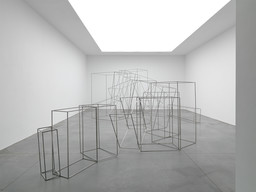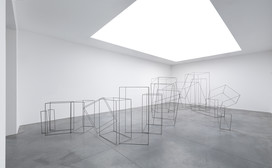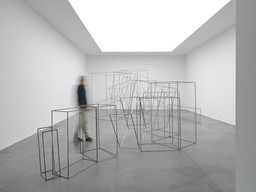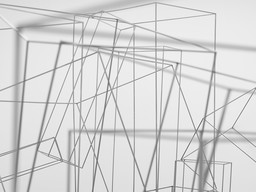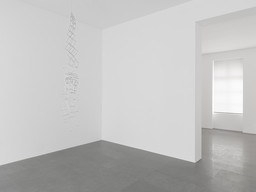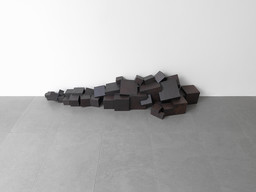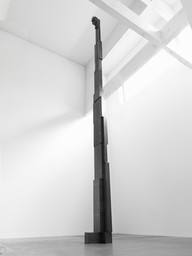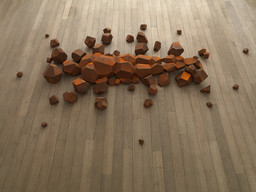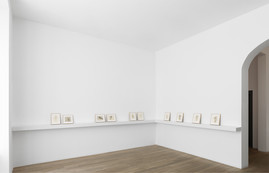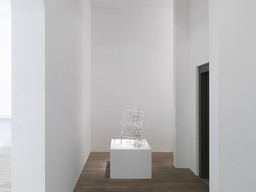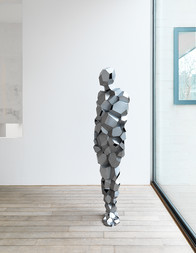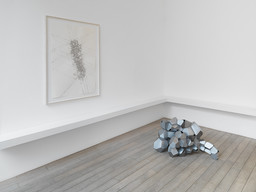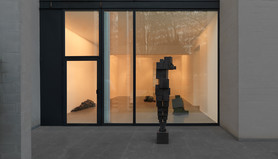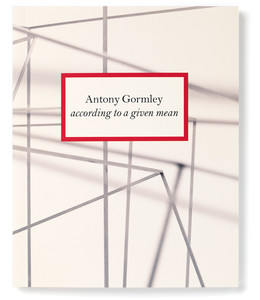Antony Gormley: according to a given mean
28 March—4 May 2013
6 rue St-Georges | St-Jorisstraat
| 1 | / | 22 |
×
Xavier Hufkens is pleased to present an exhibition of recent sculptures by Antony Gormley. Taking a variety of geometries as a starting point for an investigation of space, place and reflexive architecture, the works in according to a given mean explore the ways in which mathematical principles of spatial organisation — ultimately foreign to the body — are able to evoke states of being or mind and provoke emotional responses through purely objective means.
A number of works in the exhibition have evolved from the language of the polyhedra series that was first exhibited at Xavier Hufkens in 2009 (examples of which can currently be seen in the exhibition at Middelheim Museum, Antwerp). One example is Sum (2012), in the upstairs gallery: a floor-bound, dispersed, crystalline landscape that encloses a body caught in a moment of aggregation or entropy. These sculptures use masses and space-frames generated by the Weaire-Phelan ‘bubble matrix’ to identify human forms in space. Gormley has since further experimented with crystal aggregation, explaining: ‘I encountered a vast variety of geometries, ranging from the pyramidal forms of sodium crystals to the more jagged formation of copper sulphate. Intrigued by the ways in which iron pyrite forms natural aggregates, I began to experiment and to use cuboids to form body masses.’
according to a given mean explores two further avenues. One series of sculptures is made up of randomly distributed, chain-like groupings of orthogonal space-frames that are based on the proportions of the body. The frames are interwoven, dispersed or suspended. In Frame (2013), a six-times life-size body-form that falls diagonally across the gallery’s main space, the volumes intersect and react to the specific dimensions of the gallery whilst simultaneously lending their architectural surroundings a figural association. The work is intended to act as a catalyst: by walking in, through and around it, the viewer’s awareness of his/her own body is intensified.
A second series translates the volumes of the body into strict cubic frames or solids. There are two modes: standing forms comprising unstable towers of orthogonal cubes that seem to be at the point of collapse, and bodies at rest which have lost their orthogonal qualities and are transformed into abstract matrices. According to the artist: ‘The shift into these jumbled abstractions was inspired, in part, by iron pyrite crystal agglomerations. For instance, Resort III (2013), which is placed in the entrance to the gallery, uses the language of mineral precipitation to investigate the dependency of humans upon their habitat, whilst blocks are incorporated into the feet of the standing works to exaggerate their precariousness. This also references Brancusi’s interest in turning the object’s isolation from the floor into the structure of the object itself.’
Finally, Pump (2013), the first in a new series of works, takes full advantage of the gallery’s height. This extended body-case, with its head pinned to the floor under the pressure of its vertical, thermometer-like body, tests the relationship of consciousness to incarnation.
In a career spanning forty years, Antony Gormley has revitalised the human image in sculpture through a radical exploration of the body as a site of memory and transformation. Recent solo exhibitions include the Centro Cultural Banco do Brasil, São Paulo, Rio de Janeiro and Brasilia (2012); Deichtorhallen, Hamburg (2012); State Hermitage Museum, St. Petersburg (2011); Kunsthaus Bregenz, Austria (2010); the major touring exhibition Between You and Me (Kunsthal Rotterdam, Musée d’Art Moderne De Saint-Etienne and Artium, Vitoria, Spain, 2008–2009); MARCO, Monterrey, Mexico (2008); the Hayward Gallery, London (2007); MADRE, Naples (2006); the Calouste Gulbenkian Foundation, Lisbon (2004); the Baltic Centre for Contemporary Art, Gateshead (2003) and the National History Museum, Beijing (2003). Installations such as Field (1991, Arts Council Collection), which has been re-made by local communities across the world, and major public works such as Angel of the North (1998, Gateshead), Another Place (2005, Crosby Beach, near Liverpool), One & Other (2009, a Fourth Plinth commission for Trafalgar Square, London) and Exposure (2010, Lelystad, Holland) are amongst the most celebrated examples of contemporary British sculpture. Habitat (2010, Anchorage, USA) is the artist’s first permanent public art commission in America. Antony Gormley was born in 1950 and lives and works in London. He was awarded the Turner Prize in 1994 and made an Officer of the British Empire (OBE) in 1997.
Publication
Related Exhibitions
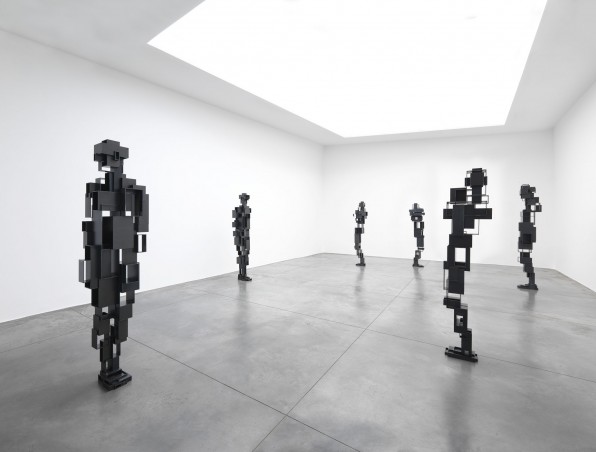
Antony Gormley: LIVING ROOM
9 March—8 April 2017
6 rue St-Georges | St-Jorisstraat
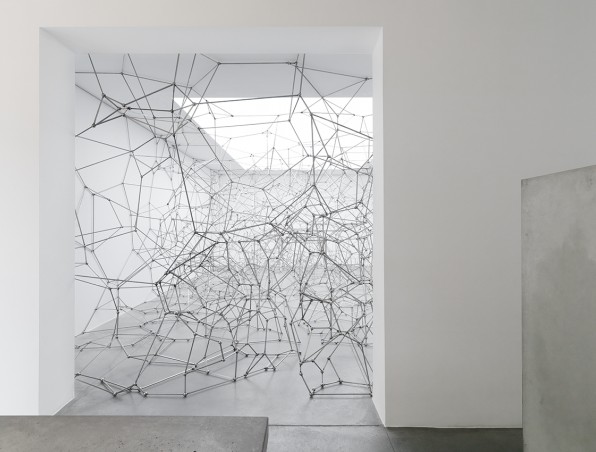
Antony Gormley: Aperture
17 September—22 October 2009
6 rue St-Georges | St-Jorisstraat
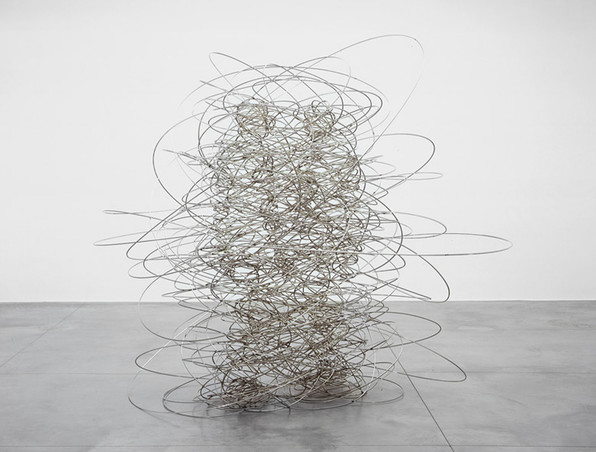
Antony Gormley: You and Nothing
14 September—21 October 2006
6 rue St-Georges | St-Jorisstraat
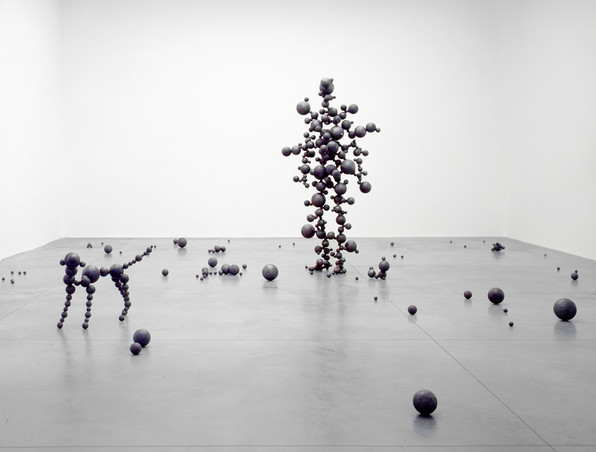
Antony Gormley
12 September—31 October 2002
6 rue St-Georges | St-Jorisstraat

Antony Gormley: Insiders and Other Recent Work
21 January—1 March 1999
6 rue St-Georges | St-Jorisstraat
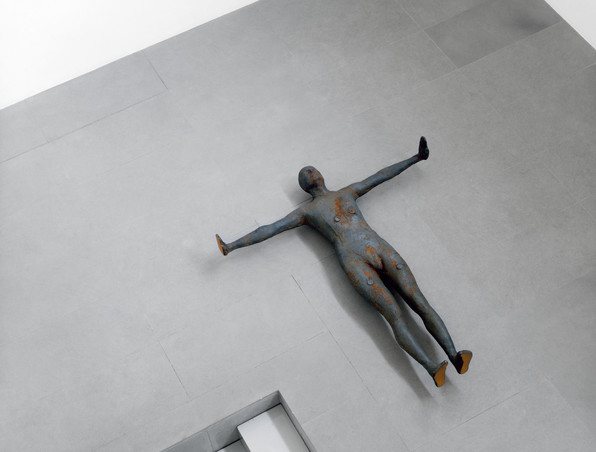
Antony Gormley: Inside the Inside
8 June—14 September 1996
6 rue St-Georges | St-Jorisstraat

Antony Gormley
28 April—30 May 1987
65 rue de l’Église St-Gilles | St-Gilliskerkstraat
